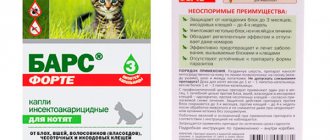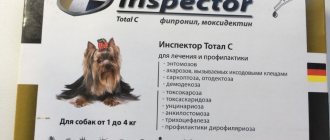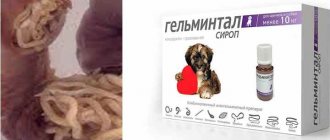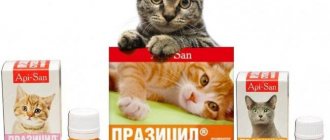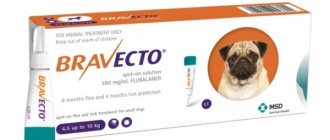Various discharge from the eyes, their swelling, inflammation and other changes can indicate not only their infection, but also more serious diseases of the body. Therefore, caring owners always carefully monitor the condition of their pets’ eyes and will never ignore any changes in them. If your pet’s eyes are red and constantly watery, or, even worse, fester, he has lost his visual acuity, or his eyes just need to be washed, drops can always help. What do you need to know about them?
Popular eye drops for dogs
In veterinary practice, the following eye drops for dogs are used for ophthalmological problems:
| Drug name | Indications for use | Dosage |
| Diamond eyes |
| For a pet weighing up to 10 kg, 1 drop of the drug is instilled; if the dog weighs more than 10 kg, 2 drops are instilled. For a single eye treatment, the duration of the course is no more than 45 days (break 10 days). If the drops are instilled 2 times a day, then the course of treatment is no more than 20 days (a break of 7 days). When used three times, the drops are used for no more than 2 weeks (break 5 days). |
| Leopard |
| The product is used after cleaning the eyes with a cloth moistened with an antiseptic solution. For the purpose of prevention, the drug is instilled once a day, 1-2 drops. During the treatment course, 1-2 drops are dripped into each eye at least 3 times a day for 10-14 days. In case of eye injury and contact with a foreign object, drop 3-4 drops 3 times a day for 1-3 days. |
| Iris | Treatment:
Prevention after injuries and introduction of a foreign object into the eye. | When treating ophthalmological diseases, the drug is dripped 4 times a day for 7-10 days. For pets weighing up to 10 kg, one drop is instilled. If the dog weighs more than 10 kg, then 2 drops. For the purpose of prevention after injury or removal of a foreign object, instill 1 drop, regardless of the pet’s weight, 4 times a day for 3 days. |
| Optimmune | Treatment of autoimmune eye diseases - idiopathic keratoconjunctivitis sicca, plasmatic infiltration of the third eyelid and chronic superficial keratitis. | The ointment is placed in the subconjunctival sac 2 times a day in the form of a strip 0.5-1 cm long. |
| Korneregel | Eye gel (drops) is used to treat:
| In the form of drops of the drug, 1 drop is used 4 times a day. After preliminary antiseptic treatment, the eye gel is placed in the subconjunctival sac 2-3 times a day. |
| Anandin | Drops are used to treat keratitis of infectious origin. | Twice a day, 2-3 drops for 2 weeks. |
| Tsiprovet | In ophthalmology, the drug is prescribed for keratitis and other eye diseases of bacterial etiology. For prophylactic purposes, drops are used in case of ingress of a foreign object, eye injury, as well as before surgery and in the postoperative period. | For 7-14 days, the dog is given 1-2 drops in each eye 4 times a day. |
Diamond eyes
The drug is based on chlorhexidine, which has powerful antiseptic properties. Taurine and succinic acid included in the composition have a regenerating effect on eye tissue, improve blood circulation in the organ, and slow down the processes of corneal degeneration. The medicine is compatible with other medications.
Leopard for all ages
Chloramphenicol and nitrofural, which form the basis of the drug, have a broad bactericidal effect against many microbes and large viruses. When using the drug, you should avoid missing the next dose.
We recommend reading about the treatment of entropion in dogs. From the article you will learn about what medial volvulus is, the causes and symptoms of the defect, stages of pathology, and treatment options. And here is more information about what retinal atrophy in dogs is and how to treat it.
Iris
The basis of the drug is gentamicin, a broad-spectrum antibiotic. In the case of a purulent infection, before using the drops, it is necessary to treat the diseased organ with an antiseptic solution.
Optimmune against swelling, dryness
The immunosuppressive properties of cyclosporine make it possible to effectively use the drug for the treatment of chronic superficial keratitis and other diseases of autoimmune etiology. Optimmune should not be used for fungal and viral eye diseases.
Korneregel
The pharmacological use of the drug is based on the regenerating properties of pantothenic acid. By stimulating healing processes, Korneregel is successfully used to treat burns and corneal injuries.
Anandin
Anandin immunomodulatory drops are most effective in the early stages of the infectious process. In addition to the antibacterial effect, the drug has pronounced regenerating and anti-inflammatory effects. Can be used in complex therapy with other drugs.
Tsiprovet
The drug, which has an antibacterial effect (it contains the antibiotic ciprofloxacin), is incompatible with other drugs that have an acidic reaction.
Diamond eyes
Leopard Iris
Korneregel
Optimmune
Anandin
Tsiprovet
Is it possible to drip Visine?
Veterinary experts do not recommend dripping Visin for eye diseases in dogs, since the drug has a pronounced vasoconstrictor effect.
Antimicrobial eye medicine for dogs Ciprovet
A popular antimicrobial eye medicine for dogs is Ciprovet; this medicine is effective for acute and chronic lesions of the conjunctiva and cornea of the eye of infectious origin. The drug should be used only as prescribed by a specialist, since Ciprovet has contraindications (atherosclerosis, damage to cerebral vessels). The drug is not suitable for treating newborn animals.
Canine ophthalmology medications
Owners of four-legged pets need to clearly understand that those medications that are used by people should not always be used to treat animals. They can only harm your student.
If you suspect he has one or another eye disease, you should rush him for a consultation at an animal clinic to determine an accurate diagnosis and prescribe the appropriate medicinal drops. Veterinary eye drops are medicinal and intended for caring for the visual organs.
But anything can happen in life. Therefore, dog owners themselves would do well to know about the most popular and currently used means that help treat and prevent eye diseases in pets. Let's look at them.
Diamond eyes for use in dogs
“Diamond Eyes” are drops for dogs that promote the symptomatic treatment of damage to the organs of vision, accompanied by inflammation, redness, itching, and excessive lacrimation. In addition, they prevent the penetration of various infections and changes in the retina of the eyes that occur in dogs as they age. They are also indicated in the treatment of mild forms of conjunctivitis. These effects are facilitated by the main active ingredients of these drops - succinic acid, taurine and chlorhexidine.
Since the medication is not potent, “Diamond Eyes” is recommended for daily use. They are not addictive.
Use them this way. Before starting treatment, as well as for daily care, remove all dried or purulent discharge and crusts from the corners of the eyes with a clean gauze swab, pre-slightly soaked in medication. And only after this, the drug is dripped in the following doses: animals weighing up to 10 kg - 1 drop, over 10 kg - 2. A similar manipulation is performed 1-3 times a day with a break of 5-10 days until a positive effect is achieved.
Eye drops for dogs of all ages Bars
"Bars" is an antibacterial drug for purely veterinary purposes, with multifaceted uses. Levomycetin, which is one of its components, is active against many microbes, certain viruses and strains of bacteria.
It is thanks to these components that Bars eye drops for dogs have an appropriate therapeutic effect in the treatment of many mucosal lesions and help prevent inflammation during injuries.
Before instilling the product, you should first carry out hygienic cleaning of the organs of vision. Then apply the medicine at the rate of 1-2 drops in one eye. Carry out the procedure 3-4 times a day for 1-2 weeks. If necessary, the course can be repeated.
When using Bars for treatment, care must be taken not to miss the next dose of the medicine. Indeed, in this case, its therapeutic effect may decrease. If this happens, the use of drops should be resumed in the prescribed manner.
Veterinary eye product Iris
“Iris” also refers exclusively to veterinary drugs. This is a highly effective ophthalmic drug based on gentamicin sulfate and polyvinylpyrrolidone. Thanks to their antibacterial properties, Iris eye drops for dogs are effective in relieving ailments of the cornea and conjunctiva. They are also used in cases of traumatic eye injuries and other lesions.
As in previous cases, the product is instilled after cleaning the organs of vision at the rate of: dogs weighing from 2 to 10 kg - 1 drop, from 10 to 20 kg - 2 drops and over 20 kg - 3 drops in one eye.
Antimicrobial drops for dogs Ciprovet
“Ciprovet” are drops whose main active ingredient is ciprofloxacin hydrochloride, which has a destructive effect on microbes, including those that are resistant to methicillin and gentamicin.
Ciprovet eye drops are used:
- to get rid of symptoms of acute and chronic types of conjunctivitis and other eye lesions
- infectious nature;
- for the treatment of ailments of the visual organs that cannot be treated by other means
- antimicrobial agents;
- as a prophylactic drug to prevent eye ailments after injuries
- and foreign objects entering the eye, as well as in connection with surgical interventions.
The remedy requires careful treatment of dogs with atherosclerosis, as well as disorders of blood circulation in the vessels of the brain. Like all medications of this type, they are injected into the conjunctival cavity of the diseased eye, 1-2 drops 3-4 times a day for a week or two until a positive result is obtained. Before this, if required, the diseased organ is cleaned according to the method indicated above.
Drops for puffiness and dry eyes of dogs Optimmun
"Optimmun" - drops for all dogs, designed to relieve them of diseases caused by autoimmune processes in the animal's body. Mostly it is dryness of the cornea and swelling of the eyeball.
The main active ingredient of the drug, choline salicylate, quickly relieves inflammation, relieves pain, and moisturizes the mucous membrane. Usually they put 3-4 drops in their eyes three times a day. This drug is also available in the form of an ointment called “Optimmun”. Which one is more acceptable is up to you to choose. It is better to use a product that will irritate your pet less.
"Optimmun" is used until a positive result is obtained. Therapy can be long-term, it all depends on the severity of the disease. The main thing is that the effect of the medicine should be regular, continuous, and the use of additional drugs is not excluded. But in the presence of fungal and viral eye infections, this drug cannot be treated.
The main disadvantage of both drops and ointments is their high cost. This is precisely the main reason for replacing them with a cheaper analogue - “Tseprovin”.
Reasons for appearance
Common causes of conjunctivitis in animals are:
- traumatic conjunctivitis can occur due to a branch, stick, sand, or grain getting into the eye;
- excessive exposure to UV rays;
- parasites (external and helminths);
- bacteria provoke a purulent process;
- some viruses;
- inflammation can spread from nearby inflamed tissues;
- ingress of various substances (household chemicals, construction dust);
- allergies to paints, dust, pollen.
Purulent conjunctivitis in a puppy has a special etiology - intrauterine infections. As a result, physiological ankyloblepharon - fusion of the eyelids - can develop.
What medications to give a dog for eye diseases
In veterinary practice, both veterinary and medical drugs are used to treat one or another ophthalmic ailment:
| Disease | A drug |
| Conjunctivitis, including follicular: |
|
| For purulent discharge: |
|
| Corneal injuries: |
|
| Keratitis: |
|
| Corneal ulcer: |
|
With purulent discharge
The key to successful treatment for purulent discharge is thorough pre-treatment of the eyes with antiseptic agents before using medications. In case of purulent exudation, the veterinarian usually prescribes chloramphenicol drops, Bars, Iris. The drugs are based on broad-spectrum antibiotics.
Anandin is prescribed to strengthen local immunity and improve tissue regeneration.
For inflammation
A veterinarian prescribes the following medications for corneal inflammation:
| A drug | Active substance | Pharmacological properties |
| Leopard |
| Levomycetin is active against large viruses and most bacteria. Furacilin, being a strong antiseptic, has a bactericidal effect. |
| Sofradex |
| The antibiotic framecitin sulfate causes the death of microorganisms. Gramicidin destroys staphylococci. Dexamethasone contained in the drops has an anti-inflammatory effect and reduces allergic reactions. |
| Tobrex |
| The antibiotic has a wide spectrum of action and is effective against bacteria such as Escherichia coli, Proteus spp., Staphylococcus spp. |
| Diamond eyes |
| Chlorhexidine is active against bacteria and large viruses. Taurine is involved in redox reactions in corneal tissue. Succinic acid reduces swelling and inflammation. |
With antibiotic: Tobrex and others
To treat eye diseases of infectious etiology, antibiotic drops are prescribed to a sick pet. Such drugs as Floxal, chloramphenicol drops, Tobrex, Bars have a good effect.
For example, Tobrex drops basically contain an antibiotic that is active against many pathogenic microorganisms. The drug is used for infectious eye diseases.
Levomycetin for inflammation
Levomycetin (chloramphenicol), which forms the basis of chloramphenicol drops, is prescribed for inflammatory eye diseases - blepharitis, conjunctivitis, keratitis. An open bottle can be stored in the refrigerator for no more than one month. Apply the drug 1 drop in both eyes 3-4 times a day. The duration of the course of treatment is no more than 14 days.
Oftalmoferon
A veterinarian usually prescribes Oftalmoferon drops for the treatment of viral conjunctivitis, punctate keratitis, and adenovirus infection. The drug is dripped 3 times a day, 1-2 drops after preliminary hygienic treatment.
Taufon
Taufon eye drops are used in veterinary practice in the complex treatment of corneal ulcers, injuries, and cataracts. The drug contains taurine, which stimulates the regeneration processes of eye tissue. Taufon for dogs is used 1 drop 2 times a day for 7-10 days.
Levomycin drops
Tobrex Oftalmoferon
Taufon
Is it possible to drip Albucid
Veterinary experts do not recommend giving Albucid containing sodium sulfacyl to a sick dog. The product often causes a burning sensation and can lead to chronic conjunctivitis.
Sulfacyl sodium
Sodium sulfacyl is widely used in medicine, being an analogue of Albucid. Both drugs are not used in veterinary practice.
Watch this video on how to properly apply eye drops and eye ointment to a dog:
Types of eye drops for dogs
General information about the most common ophthalmic drops for dogs is necessary for every dog breeder, so as not to make a mistake with the choice in critical situations. Such drugs include “Bars”, “Anandin”, “Tsiprovet” and even “human” “Tobrex”.
You can now see the current price of eye drops for dogs and buy them right here:
"Leopard"
One of the most common and universal veterinary ophthalmic drugs is Bars eye drops for dogs. This combined agent has a pronounced antimicrobial effect and is most in demand for use in cases of a tendency to infectious eye lesions.
The main active components of the drug are:
- chloramphenicol (antibacterial substance);
- furatsilin (antiseptic).
This dual antimicrobial effect helps quickly eliminate the most common eye diseases in dogs:
- conjunctivitis
- blepharitis
- keratitis, etc.
The big advantage of the drops is the most affordable price among all analogues with high efficiency. The cost of a 10 ml bottle varies between 80–100 rubles. In addition, “Bars” is the best eye drops for dogs with purulent discharge and an excellent prophylactic agent that can be used for daily eye cleansing and disinfection in case of traumatic lesions.
To treat the area around the eye (removing secretions, crusts, dirt), use a piece of bandage moistened with the medicine, and then drop 1-2 drops of it into the eyes. This procedure is carried out 4 times a day. The maximum duration of the course is 2 weeks. You can repeat after a 7-day break.
Eye drops for dogs "Bars" are an absolutely safe product that has no contraindications, except for allergic reactions to the components. If symptoms such as itching, redness of the sclera, lacrimation occur, the drug is discontinued and an antihistamine is prescribed.
"Anandin"
"Anandin" for dogs - eye drops with an immunomodulatory effect. Main active substance (anandin):
- has anti-inflammatory and wound-healing properties;
- activates the production of interferon;
- improves lymphocyte functions.
The drug activates the immune system, increasing the body's own defense and providing a comprehensive effect on viruses, bacteria and fungi. The drops are low-hazard medications and do not have an irritating, toxic or sensitizing effect. The price of "Anandin" corresponds to the cost of "Bars" drops - within 60 rubles for 5 ml and no more than 100 rubles for 10 ml.
They are recommended for use in the complex treatment of conjunctivitis in dogs that do not have individual intolerance to its components. They have no contraindications or side effects and are compatible with all medications and nutritional supplements.
The medicinal composition is instilled 2 drops into each eye twice a day. The course of treatment is continued until symptoms disappear, but not longer than 2 weeks. During this period, it is not necessary to change the dog’s living conditions and diet. If allergic irritation occurs, Anandin is discontinued and an antihistamine is used.
"Tsiprovet"
"Ciprovet" - drops with antimicrobial and anti-inflammatory effects based on the antibiotic ciprofloxacin. The drug is active against most types of bacteria and is used to treat any infectious and inflammatory eye diseases in dogs:
- inflammation of the choroid;
- ulcerative lesions of the cornea;
- blepharitis;
- keratitis;
- conjunctivitis.
In addition, "Tsiprovet" is effective as a prophylactic agent to prevent eye infection in the event of injury or contact with a foreign object.
Due to the more concentrated composition, the price of eye drops for dogs “Tsiprovet” is slightly higher than its analogues. But the drug is accessible to a wide range of consumers - its cost is 150–200 rubles per 10 ml.
The medicine is instilled 4-6 times a day, depending on the severity of the disease, for no more than 2 weeks. The dosage depends on the dog's weight:
- up to 10 kg – 1 drop;
- over 10 kg – 2 drops.
If there is heavy discharge, first instill 4-5 drops (regardless of the weight of the animal), then wipe the eye area with a piece of bandage, and then administer the required dose of the medicine.
Tsiprovet drops are contraindicated in newborn puppies up to 7 days of age and in all dogs intolerant to fluoroquinolones. In some cases, a burning sensation may appear immediately after instilling eye drops, but it goes away on its own after a few minutes.
Tobrex
Tobrex drops are an antibacterial ophthalmic drug for the treatment of eye infections in humans. This medicine is one of the few that can be used in a dog's eyes. Despite the fact that Tobrex eye drops are not intended for dogs, they do not cause an allergic reaction and can very effectively rid animals of many types of bacterial lesions.
Most often, Tobrex is prescribed to dogs for treatment;
- conjunctivitis
- keratoconjunctivitis
- blepharitis
- keratitis, etc.
The main active ingredient of Tobrex is the antibiotic tobramycin, which is effective against a large number of pathogens, except enterococci, chlamydia and anaerobic bacteria.
The drops are very effective, hypoallergenic and absolutely safe, but they are expensive. Their cost is on average 175 rubles per 5 ml, which is 2 times higher than “Tsiprovet” and 3 times higher than “Bars” or “Anandin”.
The medicine should be instilled:
- 1 drop every 4 hours for a maximum of 10 days;
- in case of acute injury, on the first day, instillation is carried out at intervals of 1 hour.
The only contraindication is individual intolerance to tobramycin. Side effects may include burning, redness, swelling of the eyelids, and lacrimation. In such cases, use of the drug should be discontinued. These symptoms will go away on their own.
Disease prognosis
Depending on the form of conjunctivitis, the prognosis for the disease is different:
- Catarrhal conjunctivitis. In the acute form it is favorable, in the chronic form it is cautious.
- Follicular conjunctivitis. It is usually favorable, but relapses are possible in the future.
- Purulent conjunctivitis. With timely treatment, the prognosis is favorable, with an advanced disease - cautious (scar formation is possible), if the cornea is involved in the process - unfavorable (the dog goes blind).
- Allergic conjunctivitis. The prognosis is always favorable; caution can be exercised only in very advanced cases.
- Chlamydial conjunctivitis. Cautious in puppies, in adult animals – favorable if handled in a timely manner.
- Viral conjunctivitis. The prognosis depends on the infection, the type of pathogen, immunity and the general condition of the animal. Usually he is cautious, but with carnivore plague he is unfavorable.
- Parenchymal (phlegmonous) conjunctivitis. The prognosis is cautious, since inflammation can spread to the cornea through panophthalmitis or retrobulbar phlegmon or trigger the development of sepsis.
- Fibrinous conjunctivitis. Usually cautious (possible scarring and distortion of the eyelids) or unfavorable (the animal goes blind).
Is it possible to apply ointment to your eyes?
To treat eye diseases in dogs, tetracycline ointment (Unguentum Tetracyclini) containing 1% oxytetracycline is prescribed.
Important! 3% tetracycline ointment cannot be used to treat eyes! It is intended for the treatment of viral eczema, purulent skin rashes, and trophic ulcers.
Tetracycline ophthalmic ointment is indicated for:
- types of conjunctivitis caused by pathogenic bacteria (tetracycline ointment is powerless against viral and fungal conjunctivitis);
- keratitis (inflammation of the eye cornea);
- blepharitis (inflammation of the eyelid);
- trachoma (chlamydia) - an infectious eye disease in which the cornea becomes cloudy, the cartilage of the eyelids changes, and follicular conjunctivitis develops, which in severe form leads to blindness;
- infected wounds and burns of the cornea.
Although the drug is considered one of the safest and does not cause side effects, there are contraindications:
- allergic reaction to tetracycline and antibiotics from its series (oxytetracycline, doxycycline, chlortetracycline, tagicil) or other components of the ointment (sodium sulfite, lanolin, ceresin, paraffin);
- pregnancy and lactation;
- chronic liver and kidney diseases in the acute stage;
- fungal eye diseases;
- use of other local ophthalmic agents.
An allergic reaction (intolerance) to the drug manifests itself in disruption of the gastrointestinal tract, redness of the eyelids and conjunctiva, anxiety, and the dog’s attempts to rub its eyes with its paw due to itching and burning. In this case, stop using the drug immediately and seek help from a veterinarian.
Instructions for use
The procedure for adding ointment is simple:
- The eyes are washed with boiled water at a warm temperature, weakly brewed green tea, and a decoction of chamomile. Tea and decoction are pre-filtered through a double cotton filter. For washing, use a sterile pipette. It is convenient to use a special sterile lotion for washing the eyes Rosinka.
- Gently pull back the eyelid.
- The required amount of ointment is collected onto the blade of a glass spatula; if the ointment is packaged in a syringe tube, you can do without it.
- Carefully place the ointment behind the eyelid, starting from the inner corner of the eye.
- After applying the drug, lightly squeeze the upper and lower eyelids together with two fingers and lightly massage from the outside with a cotton-gauze swab, evenly distributing the ointment throughout the cavity between the inner wall of the lower eyelid and the eyeball or throughout the entire eyeball.
- If necessary, apply a gauze bandage.
Important! If the dog is experiencing severe pain in the eye, then 1 drop of lidocoine (local anesthetic) can be instilled into it before the procedure.
Recommendations on dosage and number of procedures are given by a specialist. Usually the ointment is applied 3-4 times a day until complete recovery, but not more than 7 days. A longer course is fraught with complications.
A single dose of ointment, depending on the diagnosis, severity of the disease and the weight of the animal, ranges from 0.2 g to 0.4 g per eye.
For greater effectiveness, chloramphenicol drops are instilled into the eyes 10-15 minutes after the procedure.
How to put drops in a dog's eyes
When a veterinarian has prescribed eye drops for a dog, the owner must follow these steps:
- Place a small dog on your hand, and a large dog so as to position yourself behind it.
- Clean the hair around the eyes from crusts, dust, purulent discharge using a cotton pad moistened with an antiseptic solution of furatsilin, potassium permanganate, drops of Diamond Eyes, Bars.
- Pulling back the lower part of the eyelid, drip the required amount of the prescribed drug from the bottle.
- While holding the dog, you should gently massage the eyelid so that the medicine is distributed evenly and only then release the pet. Do the same with the second eye.
If the dog is prescribed more than one local remedy (drops, ointment), then a 15-minute interval must be left between the use of medications.
Signs of eye disease in dogs
It is quite difficult to protect your pet from injuries and inflammatory processes resulting from pathogenic microflora entering the mucous membrane of the eye. But regular care, use of special means and monitoring the condition of the visual organs is a feasible task. There are a number of characteristic signs that allow the owner to suspect a dog has an eye disease. It is often impossible to make a diagnosis on your own. But careful observation of the dog’s eyes and identification of alarming signs will allow you to promptly seek qualified help from a veterinary clinic.
Squinting
If your dog develops the habit of squinting one or both eyes, you should immediately take it to the vet. This behavior can be a symptom of a wide range of diseases, such as conjunctivitis or corneal erosion. It is quite difficult to detect corneal erosion at the initial stage of the pathological process. But the habit of squinting your eyes can become exactly that life-saving symptom that will allow you to diagnose the disease in time. Lack of timely treatment can lead to clouding of the cornea, and this is a direct path to partial or complete loss of vision.
The cause of corneal erosion may be:
- an inflammatory process that develops as a result of the ingress of pathogenic microflora;
- allergic conjunctivitis;
- corneal injuries;
- insufficient production of tear secretion, which leads to the development of dry eye syndrome.
If the owner ignores the characteristic squinting of the pet, then corneal erosion can develop into an ulcer within a short period of time. Experiencing pain and discomfort, the dog involuntarily squints the affected eye.
Squinting may be a sign of photophobia not associated with visual pathology. Photophobia can be observed in such dangerous diseases as canine distemper and rabies. Therefore, the owner should not ignore this seemingly insignificant symptom.
Redness or other discoloration of the conjunctiva
The reason for the appearance of a reddish tint in the mucous membrane of the dog’s eyes can be:
- allergic reaction. It can develop on food, dust, pollen of certain types of plants, medications, hair or feathers of pets, chemical reagents used by the owner for cleaning the house;
- pathological processes of the organs of vision (conjunctivitis, keratitis and many others);
- injuries resulting from physical, chemical or thermal exposure.
The owner should pay attention to the dog’s health even if the animal’s conjunctiva is too pale, yellowish or bluish. This is one of the signs of diseases not related to the eyes. Yellowness of the mucous membranes can be a sign of babesiosis, blueness can be a sign of problems with the cardiorespiratory system. The most alarming sign is the “porcelain pallor” of the mucous membranes. This symptom indicates acute blood loss, severe anemia, or other life-threatening conditions. You should consult a doctor immediately!
Discharge of pus
The appearance of purulent discharge is a serious sign of eye disease. The owner needs to observe the dog and not confuse mucus and pus. The first appears when a speck or small foreign body gets into the eye. At the same time, a tear secretion begins to be actively produced, which envelops and naturally removes the speck.
If an injury occurs to the mucous membrane of the eye, tear duct or cornea, and a secondary infection occurs, the eyes begin to fester. In this case, the owner’s delay may cost the dog his sight. The danger of purulent discharge is that it can appear only a few days after the onset of the inflammatory process. And in this case, the disease turns out to be already advanced, which means that the duration of treatment increases.
If purulent discharge appears in a puppy, then we are talking not only about pathology of the organs of vision. Perhaps the baby is developing a serious infectious disease, and it needs to be treated using a combination of drugs.
Cloudiness of transparent membranes
If your animal's eyes become cloudy, this should also be a reason for immediate consultation with a veterinarian. As a rule, such a symptom indicates serious problems, such as corneal erosion or ulcers, vascular keratitis, or the appearance of cholesterol or calcium plaques. Cloudiness can also be caused by glaucoma or degenerative changes. You should not discount possible clouding of the lens.
Breed characteristics
Many dogs of all breeds have eye diseases. However, some breeds that have structural features of the visual organs are more at risk than others of encountering this very unpleasant problem. Excessive lacrimation and various discharges have been bothering dogs of the following breeds almost from the first days of life:
- breeds with drooping eyelids, such as spaniels, sharpeis, mastiffs, basset hounds;
- dogs with bulging eyes, for example, Chihuahuas, Pekingese, pugs;
- those with long hair, for example, lap dogs, poodles, Yorkshire terriers, Afghan hounds, collies;
- Brachycephalic dogs, for example, boxers, bulldogs, Pomeranians.
Older dogs of various breeds suffer from hazy corneas due to insufficient tear fluid. With this disease, additional discomfort for the dog is caused by purulent discharge and chronic conjunctivitis.
Eye ointment for dogs
Eye ointment for dogs, along with drops, is used to treat many ophthalmological problems - conjunctivitis, blepharitis, iridocyclitis, keratitis and others. Most often in veterinary practice, dogs are prescribed drugs such as Tetracycline ointment, Solcoseryl.
After preliminary antiseptic treatment of the skin around the eye, by retracting the eyelid, the eye gel is placed in the subconjunctival space. Light massage movements of the eyelid distribute the medicine.
Algorithm for applying eye ointment to a dog
Unlike liquid dosage forms, creamy medications are used only for therapeutic purposes; drops should be used for prevention.
Purpose of eye drops
"Diamond Eyes"
Drops are recommended for daily care of your pet's eyes. They have a slight bacteriostatic effect and can help relieve redness, itching, and reduce lacrimation. They contain taurine and antioxidants. They are a first aid remedy in case of foreign body penetration or minor injuries, as well as for the prevention of age-related changes.
"Leopard".
This product as an active ingredient contains 2 components - furatsilin and chloramphenicol, therefore it is active against a wide range of pathogenic microflora. The drops also have anesthetic and anti-inflammatory properties. They are used for the prevention and treatment of keratitis, all types of conjunctivitis, and blepharitis. Bars drops are also used in the treatment of eye injuries.
"Iris".
The active ingredient gentamicin sulfate is active against a wide range of pathogenic microflora. Penetrates through the cornea and maintains optimal concentration of the drug inside the eye. The ophthalmic drug has proven itself in the treatment of keratitis, conjunctivitis, ulcers and erosions of the cornea, as well as blepharitis and uveitis. Particularly active against pyogenic microflora.
"Tsiprovet."
Characterized by a wide spectrum of antimicrobial action. It is used to treat conjunctivitis, blepharitis, septic iridocyclitis, and corneal ulcers. It is also used by veterinary ophthalmologists as a prophylactic agent in the postoperative period and to prepare the visual organs before surgery. In addition, it is a means of prevention in case of foreign body penetration or corneal injuries. "Tsiprovet" even affects microorganisms that are resistant to most antibiotics, such as chlamydia and mycoplasma.
It should be understood that eye diseases should be treated by a specialist, and not by the owner, breeder or pharmacist. If eye drops eliminated, for example, purulent discharge from your dog, this does not mean that they will help the animal with a completely different problem?
Why not?
Animals must be treated strictly with veterinary medications. It is important to note that it is prohibited to use Albucid, used in pediatric ophthalmology, to treat pets.
Some owners do not go into detail about the differences between drugs for humans and animals or simply want to save money, since drugs for animals are more expensive, but thereby cause more harm to their pets.
Albucid has a merciless effect on dog eyes, causing extreme burning, to the point that it can burn the cornea. In a milder case, so to speak, the drug causes chronic conjunctivitis.
Animal eye care rules
Caring for your pet's eyes should be daily and include examining and cleaning the eyesight.
Hygiene
Hygiene procedures include the following elements:
- Removing dirt, dust, crusts, secretions. For this purpose, use an infusion of tea, a decoction of chamomile, or antiseptics such as a solution of furatsilin, potassium permanganate.
- Instillation of eye drops for preventive purposes. As a rule, dogs with a brachycephalic skull structure (pugs, bulldogs, Pekingese), with thick hair (schnauzers), as well as pets with entropion of the eyelids (basset hounds, sharpeis) need careful care.
Treatment
Therapy for ophthalmic diseases involves not only the use of drops and ointments, but also intramuscular injections of broad-spectrum antibiotics, vitamin and mineral supplements to food. In some cases, surgical treatment is prescribed (corneal ulcer, cataract, etc.).
Disease Prevention
Prevention of eye diseases in dogs includes the following measures:
- Daily examination of the organs of vision for foreign bodies, injuries, purulent discharge, lacrimation.
- When bathing, avoid getting detergents in your pet's eyes.
- Long-haired breeds need to have their facial hair trimmed to keep it out of their eyes.
- Vaccinate your pet against infectious diseases in a timely manner.
We recommend reading about treating eye injuries in dogs. From the article you will learn about the causes of eyeball injury in a dog, types of damage, symptoms and diagnosis of eye injury, and treatment methods. And here is more information about why barley occurs in dogs and how it is treated.
Eye drops for dogs are widely used for the prevention and treatment of various ophthalmic problems. The preparations may contain antibiotics, antiseptics, vitamins and other active substances. Before using the medicine, it is necessary to carry out antiseptic eye treatment. The same is done if a veterinarian has prescribed eye ointment to treat an illness.
Eye drops and ointments
Dog eye treatment is often done with drops and ointments. They are especially effective for conjunctivitis, blepharitis, and keratitis. Both veterinary and human drugs are used. Diamond eyes drops are effective for treating conjunctivitis in dogs; they are sold at any veterinary pharmacy.
Technique for introducing drops into a dog's eye
But what to do if there is no way to quickly get to a veterinary pharmacy - human resources will also help you. If your dog's eyes are watery, boric acid can be instilled, and purulent discharge should be treated with tetracycline ointment.
Video on eye rinsing in dogs
Veterinary ointments, lotions and drops for eye treatment
Diamond Eyes - eye drops for dogs and cats. The drug contains as active ingredients: chlorhexidine digluconate - 0.00015 g/ml, taurine - 0.02 g/ml, succinic acid - 0.001 g/ml. Dogs weighing up to 10 kg - 1 drop, dogs weighing more than 10 kg - 2 drops. When treating the eyes 3 times a day, the drug is used for no more than 14 days, after which a 5-day break is taken.
Contagiousness of conjunctivitis
Important! Conjunctivitis of viral or bacterial etiology is contagious to humans.
The disease can be transmitted by airborne droplets or contact. Most people become infected during treatment at home, so you need to maintain personal hygiene to prevent the bacteria from being transferred to yourself. Infection with fungal conjunctivitis occurs when the immune system is weakened, so for prevention you should take multivitamins. Still, the risk is insignificant, the main thing is to maintain personal hygiene.
Useful video
Watch this video about how and what to wash your dog's eyes with:
Similar articles
- Anti-inflammatory drugs for dogs: main... Non-steroidal anti-inflammatory drugs for dogs relieve pain, restore physiological function... A wide variety of dosage forms are used for treatment: eye drops, ointments, injections, tablets... Read more
- Eye injury in a dog: causes, treatment, dog after...
Causes of eye injuries in a dog. Experienced dog breeders and veterinary ophthalmologists most often encounter... Eye drops should only be used after examination by a veterinary ophthalmologist and on his recommendation. To relieve inflammation and swelling in veterinary practice... Read more - Stye in a dog: does it happen on the upper, lower eyelid...
Internal stye in a dog's eye is dangerous because inflammation can quickly spread to... In some cases, in addition to a creamy medicine, a veterinarian may prescribe anti-inflammatory and antibacterial drops, for example chloramphenicol, to a sick pet... Read Further - Retinal atrophy in dogs: what causes...
Fundus in dogs with retinal atrophy at the initial and middle stages. ... To alleviate the condition of these ailments, a veterinarian usually recommends eye drops with an anti-inflammatory effect. Read more - Inversion of the eyelid in a dog: medial, lower, third...
In some cases, a specialist will prescribe eye drops to a sick dog. Before the operation, the animal is kept on... Caring for the animal is reduced to the use of eye drops prescribed by a veterinarian 3-4 times a day. In some cases, the seams are treated with Tetracycline ointment. Read more
Dosage
Any antibiotics should not be used for more than 10 days, otherwise they will have a negative effect on the body. This is the first rule. And second: any antibacterial drugs can be used only as prescribed by a specialist and in the dosage that he prescribes. Otherwise, you may not help your pet, but only do more harm.
Antibacterial drugs have the property of penetrating into the fetus through the placenta; the maximum concentration is observed in the kidneys, liver, and lungs. Exceeding the dosage “harms” these organs.
Levomycetin can be given to animals only as prescribed by a veterinarian and strictly observing the dosage. The standard amount for adult dogs is 0.25-0.5 g, but not more than 2 g per day. You should strictly follow the treatment regimen for bacterial diarrhea - give the medicine three times a day half an hour before meals or an hour after feeding.
There are no restrictions for puppies, but the dose is much lower and the pet’s condition should be carefully monitored. The medicine, in addition to other side effects, often causes an allergic reaction.
If Levomycetin is prescribed to a dog as a means of therapy for eye disease, then 2 drops should be dripped into each eye 3-4 times a day, after removing dried crusts and pus with a sterile napkin with saline solution. The course of treatment is 5 days; if no improvement is observed during this time, the veterinarian will replace the drug.
Prevention
It is easier to carry out measures to prevent the disease than to treat purulent inflammation in the acute phase. If it is difficult to avoid infection with conjunctivitis, then every dog owner can reduce the risk of formation and stop the development of the pathology.
Important preventive measures:
- caring for the dog - the eyes should be periodically wiped with a sterile cloth to remove blockages;
- receiving timely vaccinations - information can be obtained from a veterinarian;
- moderate walks - the dog’s stay in an active state should not be long, associated with hypothermia, overheating of the animal, contaminated areas and thorny bushes should be avoided;
- restriction of communication - the dog should not meet sick people or homeless animals;
- Nutrition rich in mineral components and vitamins to create strong immunity.
The pet's sleeping place must be protected from drafts and humidity. The litter should be replaced regularly, at least once a week. A healthy pet brings joy to the owner and the whole family. Proper care and care will protect the animal from an unpleasant disease and will preserve the clean and clear look of your beloved dog.
Signs and symptoms
For all types of conjunctivitis, the symptoms are similar:
- redness of the mucous membrane of the eye;
- excessive tearing;
- loss of hair around the eyelids and eyelashes;
- swelling;
- the appearance of purulent or mucous discharge.
When the disease occurs, your Yorkie experiences discomfort and a strong burning sensation (in the eye area). Behaves nervously or passively, often scratches your eyelids with your paw and squints your eyes.
ALBUCID (Sodium Sulfacyl) /
- Medicines Obstetrics and gynecology
- Anesthetics
- Antibacterial, antimicrobial and anthelmintic drugs
- Hepatotropic agents
- Homeopathy
- Dermatology
- Immunotropic agents
- Treatment of the gastrointestinal tract
- Oncology
- Ophthalmology
- Rheumatology, neurology
- Respiratory and antihistamines (antiallergic)
- Cardiovascular and diuretic drugs
- Metabolism
- Urology and means of correcting sexual function in men
- Central nervous system and drugs used to treat smoking, alcoholism, drug addiction
- Endocrinology
- Antifungal
- Anesthetics
- Antibacterial, antimicrobial and anthelmintic drugs
- Hepatotropic agents
- Homeopathy
- Dermatology
- Immunotropic agents
- Treatment of the gastrointestinal tract
- Oncology
- Ophthalmology
- Rheumatology, neurology
- Respiratory and antihistamines (antiallergic)
- Cardiovascular and diuretic drugs
- Metabolism
- Central nervous system and drugs used to treat smoking, alcoholism, drug addiction
- ↓ Show all ↓
- Endocrinology
- Mom and baby Feeding accessories
- Glucometers
- First aid kits
- Lubricants
- Cotton wool, cotton swabs
- Gaskets
- Medical procedures
Useful materials:
- Cutaneous horn General description of the disease Cutaneous horn on the forehead or face (ICD 10 code - L57.0) -...
- Itching and odorless discharge Main causesBefore considering the factors that provoke the appearance of discharge that has a sour odor, it is necessary to immediately note...
- Normal temperature in animals Normal temperature in different types of animals Veterinary services Day hospital for animals Veterinary certificates Vaccination…
- Discharge in women What kind of discharge between menstruation is considered normal? Female discharge normally consists of mucus from the cervical canal, dead...

